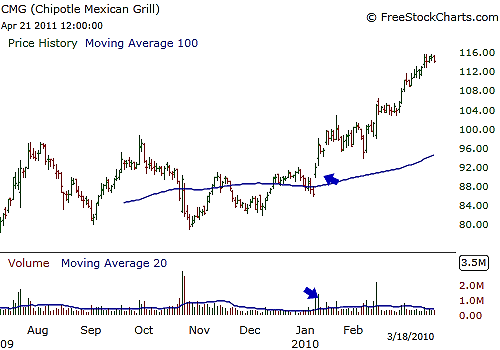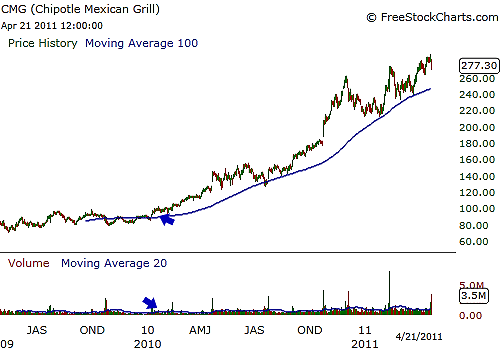
HOT TOPICS LIST
- MACD
- Fibonacci
- RSI
- Gann
- ADXR
- Stochastics
- Volume
- Triangles
- Futures
- Cycles
- Volatility
- ZIGZAG
- MESA
- Retracement
- Aroon
INDICATORS LIST
LIST OF TOPICS
PRINT THIS ARTICLE
by Billy Williams
Breakout trading can turn into "fakeout trading" as floor traders manipulate the market, but if you know this effective entry method developed by two trading legends, you can beat them to the punch for large gains.
Position: Hold
Billy Williams
Billy Williams has been trading the markets for 27 years, specializing in momentum trading with stocks and options.
PRINT THIS ARTICLE
STRATEGIES
How To Use Pocket Pivots To Catch Early Breakouts
04/25/11 02:09:17 PMby Billy Williams
Breakout trading can turn into "fakeout trading" as floor traders manipulate the market, but if you know this effective entry method developed by two trading legends, you can beat them to the punch for large gains.
Position: Hold
| Breakout trading has been one of the proven approaches to trading stocks since the days of Jesse Livermore and Bernard Baruch, possessing a proven track record of catching fast-moving stocks that accelerate at a bone-crushing pace to rack up impressive gains of 50%, 100%, 200%, or greater. Yet, one of the things that frustrates traders beginners and experienced alike is that the breakouts themselves are often "fakeouts." Stocks that are breaking out to new highs have a statistical edge, but depending on the price and volume of the stock, that can fail or worse, be targeted by professional floor traders. The pros on the trading floors know this method and can run a stock up to the breakout entry point, then sell it as breakout traders rush in with long orders only to meet with a wild flurry of selling as the floor traders exploit the move and quickly cause it to lose its upward momentum. As a result, the move oscillates back and forth, then begin to drift downward before gaining its upward strength but can often drift down only to hit the stop-loss orders, causing you to take a loss. Successful speculation does not have any real secrets but there are "micro-methods" for dealing with aspects of the business. See Figure 1. |

|
| FIGURE 1: CMG. CMG traded within a tight range leading up to early January 2010 where its price action contracted even tighter on low volume when price suddenly broke higher, signaling a pocket pivot had formed. |
| Graphic provided by: www.freestockcharts.com. |
| |
| Specifically, trading is a lot like playing poker in that you trade the guy on the other side of the trade. That's what the floor traders are doing -- playing against you because they know your method and customize their approach to capitalize on the weakness of your approach. It is a game of chess that many aspiring traders (and many experienced traders) do not fully grasp and fail to act on. In this scenario, you must first realize that floor traders do not move a stock with sufficient force to result in a runaway breakout move, but they can artificially push a stock around if they have sufficient buying power either as an individual or as a group. Realizing this, you must ask yourself: What other group has more buying power than the floor traders? Who would cause their approach to fall apart in the right context of the market itself? Answer: Institutional traders. It is the major institutions like mutual funds, hedge funds, and pension funds that command trillions of dollars of investment capital on a collective basis and their buying power is so immense that if you combined all the floor traders buying power together, they could not go to battle with one of these major billion-dollar players. See Figure 2. |

|
| FIGURE 2: CMG. CMG went on to gain almost 200 points from a pocket pivot entry of $91.89 to as high as $289.35, on April 20, 2011. The early entry would have helped you avoid the drifting price action after the initial breakout before CMG went on to gain a potential 215% gain. |
| Graphic provided by: www.freestockcharts.com. |
| |
| So now you must scan a stock's price action and locate a stock that is contracting within a tight price range within a base pattern. It is in these base patterns that a breakout move will occur as the stock trades up through the upper resistance point of the chart pattern but before it does, it should trade within a tight range on low trading volume first. The reason is that institutional trades have to split up their buy orders over several days leading up to a potential breakout because they can get their orders filled at much better prices, but their buying is revealed in the trade volume leading up to the breakout move. Buying a breakout within a breakout allows you to enter this trade early and even if floor traders momentarily sell into the initial breakout move as price trades up through resistance, it will not affect you nearly as badly since you got in early and can wait for the stock to find its legs and push higher. |
| This entry is called a "pocket pivot" and was detailed in the book "Trade Like An O'Neil Disciple" by Gil Morales and Chris Kacher. Based on an exhaustive study that they did on their own trades going back as far as 1990, these two experienced traders realized that the institutional traders had a "tell" (in poker, a sign that gives away their advantage) and that it could be capitalized on by a skilled speculator. Spend some time going through your charts and even when you capitalize on a solid breakout move, look for spots within the stock's trend where price contracts, adding to a position where the conditions are met for pocket pivot to trigger and continue to ride the momentum higher to larger gains. |
Billy Williams has been trading the markets for 27 years, specializing in momentum trading with stocks and options.
| Company: | StockOptionSystem.com |
| E-mail address: | stockoptionsystem.com@gmail.com |
Traders' Resource Links | |
| StockOptionSystem.com has not added any product or service information to TRADERS' RESOURCE. | |
Click here for more information about our publications!
Comments

|

Request Information From Our Sponsors
- StockCharts.com, Inc.
- Candle Patterns
- Candlestick Charting Explained
- Intermarket Technical Analysis
- John Murphy on Chart Analysis
- John Murphy's Chart Pattern Recognition
- John Murphy's Market Message
- MurphyExplainsMarketAnalysis-Intermarket Analysis
- MurphyExplainsMarketAnalysis-Visual Analysis
- StockCharts.com
- Technical Analysis of the Financial Markets
- The Visual Investor
- VectorVest, Inc.
- Executive Premier Workshop
- One-Day Options Course
- OptionsPro
- Retirement Income Workshop
- Sure-Fire Trading Systems (VectorVest, Inc.)
- Trading as a Business Workshop
- VectorVest 7 EOD
- VectorVest 7 RealTime/IntraDay
- VectorVest AutoTester
- VectorVest Educational Services
- VectorVest OnLine
- VectorVest Options Analyzer
- VectorVest ProGraphics v6.0
- VectorVest ProTrader 7
- VectorVest RealTime Derby Tool
- VectorVest Simulator
- VectorVest Variator
- VectorVest Watchdog
